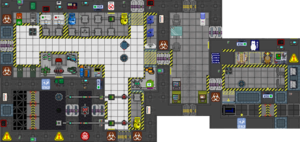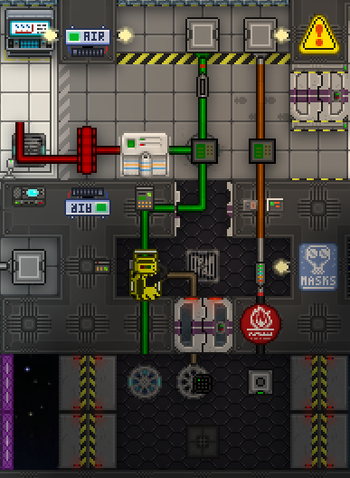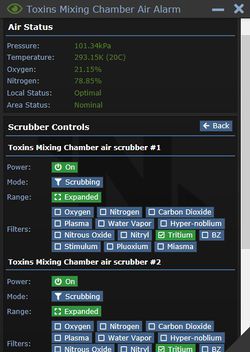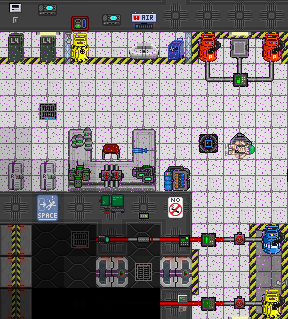Руководство по токсинам
| Моя твоя не понимать!
Эта страница была украдена с TG и за ее перевод и актуализацию еще никто не взялся. |
| Научный руководитель Роберт Оппенгеймер says: "Вот, держи эту бомбу. Только имейте в виду, что я не несу прямой ответственности за любые терракты, которые могут быть или не быть вызваны вашими действиями." |
Токсины это секция научно-исследовательского отдела станции. Было время, когда нахождение в этом месте означало, что вы являетесь плохой парень но с появлением научных бомб, Это больше не тот случай.* Вместо этого, будучи надежным производителем бомб, вы получите похвалу и одобрение, когда экипаж поймет, что вы использовали всю смесь для завершения сложных исследовательских экспериментов и получили до 50 000 кредитов из бюджета на исследования, вместо того, чтобы использовать ее на то что бы превратить Станцию в кусок летающего металолома Ура, науке!
*Обратите внимание, что после первой исследовательской бомбы остальная смесь бомб применяется только для переработки необработанных ядер аномалий через Implosion Compressor, или для более мерзких целей (или очень неэффективная, но интересная добыча лаваленда).
 Немного информации
Немного информации
Последний пересмотрPotatoMasher, 5/15/21. Присылайте любые вопросы или комментарии в мой адрес.
Основная цель Токсинов - создать газовую смесь, которая при соединении вызовет мощный взрыв, достаточно большой, чтобы формула смеси позволила завершить необходимые для исследования эксперименты (а также достаточно ценной, чтобы продать ее с выгодой, потому что мы в SS13 ЛЮБИМ деньги). Ряд технологий, связанных с оружием и взрывчатыми веществами, требуют завершенных экспериментов с токсинами, чтобы их можно было исследовать. Вы также можете заработать максимальную сумму в 50 000 кредитов для бюджета Исследовательского отдела, что позволяет РД приобрести множество товаров и дополнительные необработанные ядра аномалий из груза. На данный момент бесполезно, так как консоли заказов в отделах позволяют делать заказы бесплатно, но с долгим кулдауном
В этом разделе рассматривается единственный способ получения исследовательской бомбы "50k", которая позволит получить сладкую прибавку к бюджету, а также завершить все необходимые эксперименты с токсинами. Однако существует не один способ изготовления бомбы, поэтому не стесняйтесь экспериментировать, если вы уверены, что не взорвете весь отдел.
Введение
Обычная бомба состоит из двух резервуаров, прикрепленных к перепускной клапану Для готовой исследовательской бомбы один из этих баков будет заполнен смесью переохлажденного кислорода и трития (33% трития и 66% кислорода при температуре около 43 К), а другой бак будет заполнен перегретой плазмой. (8000-32000K температуры), обеспечивая энергией.
Тритий появляется тогда, когда плазма сгорает в богатой кислородной среде, обычно около 3%-97%. В общей сложности мы сожжем в нагревательной камере лаборатории токсинов три из четырех баллонов с кислородом, с которых начнем, а затем медленно подадим плазму и зажжем ее. Горячие газы занимают много места, поэтому мы захотим охладить тритий сразу после его создания, чтобы уменьшить его объем и помочь нам сохранить как можно больше. (Кроме того, если вы этого не сделаете, контейнеры, вероятно, расплавятся, и вы будете этим парнем.) все инструменты который вам нужны для этой комнаты: разводной ключ, отвертка, лом, анализатор газа и RPD. При прокладке трубопроводов с помощью RPD помните, что по возможности следует избегать использования серых труб, поскольку они автоматически соединяются со всеми остальными цветными трубами. Кроме того, цветовое кодирование помогает визуальной ясности и организации.
Первоначальный трубопровод
Для этой установки мы добавим дополнительный скруббер и порт канистры для извлечения сверхгорячей плазмы, необходимой во время горения смеси.
Прежде чем делать что-либо еще в лаборатории токсинов, вам следует захватить пожарный костюм. Вам придется войти в саму смесительную камеру, которая начинается как вакуум; пожарный костюм и шлем защитят вас от низкого давления. Наденьте пожарный костюм, пожарный шлем и кислородный баллон/маску и откройте шлюзы. Как минимум, вам нужно добавить один скруббер на другом слое (я обычно использую слой 2 с коричневыми трубами), а также трубы, проходящие внутри шлюза с портом для канистры на конце между внутренней и внешней дверями. По желанию вы можете подключить больше скрабберов к приемной трубе. Большее количество скрубберов увеличивает количество трития, которое вы можете собрать до того, как он сгорит в водяной пар и С02. Как только вы будете удовлетворены, выйдите из смесительной камеры и вернитесь к внутренней двери. Смените пожарное снаряжение, оно вам больше не понадобится (если, конечно, вы не устроите пожар).
Go inside the airlock и установите входной газовый насос на 4500 кПа и переделайте выходной трубопровод в верхней части. После того как вы максимально усилите входной насос, вы можете начать подсоединять баллоны с кислородом к входному разъему, открыть клапан и просто позволить кислороду поступать в смесительную камеру, пока вы работаете. Вы захотите заменить впускной клапан насосом (давление или объем - оба варианта подходят, но объем имеет большую пропускную способность и обычно используется в пользовательских трубопроводах). Замените напорный насос, с которого вы начинали, на прямую трубу. Регулярно проверяйте кислородный баллон, чтобы убедиться, что он пуст, и заменяйте его, если он пуст, пока у вас не будет три баллона. В какой-то момент вы также захотите напечатать из пластали несколько канистр второго уровня; вы можете легко получить пласталь из РНД в протолате путем поиска выбора "Железо + плазма", предполагая, что шахтеры принесли сладкую сладкую плазму. Как только вы закончите подключайте эту канистру в порт между шлюзами которые мы ранее сделали между внешним и внутренним шлюзом.
Настройка термомашин
To reach our target temperature of about 43.15 Kelvin, we're going to need to upgrade our Thermomachines with Tier 2 Lasers, which should by now be available from the Science Protolathe in Research and Development. If not, consider liberal application of a Toolbox to your fellow scientists heads, and/or research Industrial Engineering yourself and print 4 of them. You can also use a Rapid Part Exchange Device (RPED) to install them quicker.
Next, head back to your den and the unsecure one of the Thermomachines (screwdriver to open the panel, then right click with a wrench), and position it so it connects to your output pipes just below the pump you installed. Upgrade this Thermomachine either by using a RPED or by dismantling and rebuilding it with the new lasers. Upgrade the other Thermomachine, too. In both cases, use your new lasers rather than the ones that pop out of the machine when you crowbar it. Turn both Thermomachines to 'Cooling' and set the temperature to 43.15 Kelvin, then turn them on.
Since Thermomachines on Cooling mode are basically deluxe heat transfer pumps, you need to connect the output (red) end of the machine to something to dump the heat from the hot tritium coming out of the mix chamber elsewhere. Thankfully, it's easy to connect the machine's output to the station's red waste pipe loop. Set your pipe color to red and place a Layer Adapter next to the Thermomachine's output (the one you are using to cool the mix chamber output pipe). Either use a T-Ray Scanner or rip up some floor tiles to locate the station's red waste loop in the lab, and place more red pipes on layer 2 until you get a connection.
Note: Sometimes the Thermomachines fail to properly cool down to the desired temperature. If you find you can't the tritium to cool down enough, you may have to research Tier 3 Lasers to reach 43.15k. These will require two extra technologies and cost some uranium, so you better hope the shaft miners decided to come back alive with some before running off to become a Monster Hunter.
Now for the last bit of prep. The blue Portable Pumps found in Toxins Storage can cram more gas into the gas tanks we use for the bomb just like the T2 canister; lets use it for our super cooled oxygen. Take your fourth and last Oxygen canister, wrench it to the right side of the gas filter setup in the room, take one of the Portable Pumps and wrench it to the other side and turn the filter on without actually filtering anything. Once done, all of the oxygen should have moved from the canister into the portable pump. Unwrench the pump and bring it over to the second Thermomachine. Wrench it into the directly adjacent connector port, and ensure the Thermomachine is on and set to 'Cooling' at 43.15 k. The portable pump is now filled with chilled oxygen ready for our bomb mix.
Воспламенение и производство трития
At this point, you should have three full canisters worth of Oxygen in the Toxins Mix Chamber, and your setup should look something like the image on the right. If you've made it this far without any issue, great work! We have the cooled oxygen, now we just need the chilled tritium and the super heated plasma. Let's get onto the dangerous stuff now.
Start by going into the airlock and set the input pressure pump to 50 kPA. This sets a slow rate of input to trickle in plasma as fuel for the soon to be roaring fire.
Next, we need to program the scrubbers to actually scrub out the tritium we want, while leaving the waste gases we don't want behind. Open the interface of the Toxins Mix Chamber Air Alarm next to the interior airlock by left clicking on it. Select 'Scrubbers' to display a list of all scrubbers in the mix chamber. For each one, set the range to 'Extended' and scrub for 'Tritium', and turn them ON if they aren't already. As for the scrubber we added to collect plasma, set that to scrub for 'Plasma' instead, but don't turn it on yet. We will turn the plasma scrubber on during the burn once the fire gets hot enough!
After your scrubbers are programed, go grab a Plasma canister from storage. Wrench it to the input connector and as soon as you see purple gas going into the mix chamber, activate the mix chamber igniter using the small button near the mix chamber Air Alarm (check the name of it first by examining it, you don't want to accidentally open the chamber vent blast doors). After a few moments the fire should become blue and you'll start creating Tritium, which will automatically be scrubbed into your pipe network up to the volume pump (LEAVE THE PUMP OFF FOR NOW). The freezer will work hard to cool it down while the scrubber keeps putting hot Tritium in the pipes.
Now that the tritium is being created, what about the plasma we need? Go find the mix chamber console somewhere in the room. The console will give you the temperature of the chamber, pressure of the chamber, and list of all the gases in the chamber as well as their percentage. Watch this carefully until the temperature reaches about 15,000 kelvin. Once it does, go ahead and turn on the plasma scrubber from the Air Alarm we set up earlier. If you check your T2 canister you have wrenched inside the airlock, you should see that it's now being filled with pipping hot plasma. Watch it and let it siphon plasma until the canister reaches a pressure of over 3200kPa, then shut off the plasma scrubber.
Now back to the tritium. Take a second blue Portable Pump and wrench it to the Output of the heating chamber but KEEP THE VOLUME PUMP TURNED OFF. Keep analyzing the pipes with the Tritium in it. Soon, you should stop getting new Tritium (the 'mol' value will stop going up) and the temperature should approach our target 43.15. Anything below 45 is fine. Then, and only then, turn the Volume Pump on to put all the Tritium in the Portable Pump. Once the Portable Pump is filled and the output pipes are empty, unwrench the Portable Pump.
If you want to clean out the output pipes for future reuse, here's how. Turn the Volume Pump off and unwrench it, then re-wrench it. Doing so will make any leftover gases in the pump vanish and clean it, as it's impossible to completely empty it out normally. Turn the Freezer off and rebuild it entirely too to clear it's gas storage. If you have small trace amounts of Tritium in the pipes, don't worry about it too much. At super small mol counts it doesn't affect much at all.
That's it! If you did it right you got all the gases you need now, and the hard part is over. Now comes the fun part - actually building the bomb and blowing it up.
 Заключение сделки - создание исследовательской бомбы
Заключение сделки - создание исследовательской бомбы
If everything went right, you should have two Portable Pumps and a tier 2 canister. One pump filled with about 43.15 Kelvin Oxygen, one with about 43.15 Kelvin Tritium and a T2 canister with hot (~8000+ Kelvin) Plasma. Lets put this bad boy together.
Head to the Tank Storage Unit, grab a Plasma Tank and an Oxygen Tank, and load them into one of the white Portable Scrubbers and empty your tanks completely of Plasma and Oxygen, respectively. Put the empty blue tank in the Tritium Pump, set the target pressure to 850 kPa, set direction to In and turn on the pump. Wait for the tank to fill, then turn off the pump. Take the tank you just filled to the Oxygen pump and fill it up until it's full by setting the direction to In and turning the pump on at 2533 kPa pressure. Take the other empty orange tank and fill it in its entirety with Plasma from the T2 canister.
Your gas tanks are now ready. Now you just need to put them together along with a signaler. Attach both tanks to a Tank Transfer Valve (they look like manual values). Pick up a signaler and change the signal code to whatever you want. Use a screwdriver on the signaler to change it to attachment mode and attach it to the Tank Transfer Valve. Head over to the launch site and place the TTV on the mass driver in the room to the right, shoot it to the bomb site and when it's there send the same signal code using your PDA or another signaler.
If you did everything right, the entire station should violently rock and a machine should inform you about your success, along with any experiments you completed and the 50,000 credits you earned! If you want, you can turn the Intercom next to the machine on before detonating your bomb to broadcast the test results on the common radio. That will (sometimes) stop the crew from asking what the hell just happened.
Watch this somewhat outdated video for a concise but out of date guide to toxins. The video isn't up to date with the latest /tg/ features such as the changes to Thermomachines and smart pipes.
 Принципы
Принципы
or, "How it Actually Works", or, "Read if You're a Nerd".
A TTV does not explode on its own: it only connects two tanks, and produces an explosion based on the same formula tanks themselves use for overpressure.
The explosion of a TTV depends entirely on how quickly the pressure rises in the tanks. By this principle, the most effective way to make a TTV is to have as much gas as possible in one tank, and as much energy as possible in the other. This is why we make oxygen/plasma bombs: in one tank, you get the enormous heat capacity of plasma combined with enormous heat - in the other, you try to fit as much oxygen as possible in the tank, and this is most effectively done via cooling. Since the gas needs to change in pressure very fast and very much, we use a gas with a low heat capacity (oxygen's is 10 times lower than plasma's). As a bonus, hot plasma and oxygen burn, which raises the pressure that extra bit.
Even though the max capacity for explosions can be safely hit with these bombs, the Tachyon-Doppler Array reads the blast size that the bomb would have, were there no maxcap at all. This is called the "theoretical" radius. For this reason, even if they don't explode any more violently, tritium based research bombs get a way higher score on the array.
The tritium is placed in the oxygen tank, as it has a heat capacity even smaller than oxygen's (half of it to be precise). It is kept at roughly a ratio of 66% oxygen to 33% tritium, which is the optimal ratio for it and hydrogen. Once the plasma feeds the energy into the cold tank, the violent tritium burn raises the pressure considerably, producing a much larger theoretical boom.
You might be asking: how far can we go with this? Well, if for some ungodly reason you're playing on a server with the maxcap disabled in the config (or, much more likely, if you disabled it yourself on a local build), you can make some pretty large bombs. The largest one has hot hyper-noblium in the hot tank (10 times larger heat capacity than plasma, the highest of all) and a very densely packed oxygenated tritium payload in the cold tank. Unfortunately, hyper-noblium stops all reactions such as combustion, but on very high temperatures the mole count should be negligible.
If you try this out, you will begin to understand why the maxcap exists. This is the true legacy of Cuban Pete.
 Implosion Compressor and Anomaly Refining
Implosion Compressor and Anomaly Refining
That funny-looking box in the toxins launch room does more than just sit around. It's the main way of getting anomaly cores.
What's an anomaly core?
Anomaly cores are essentially an item with the special property of being able to exist only in a very small number (currently eight) per type. They're used to give functionality to several high-end research items, and can be obtained in one of two ways:
- Defusing Anomalies with an analyzer and signaller, or with an Anomaly Neutralizer
- Buying raw cores from Cargo or using the random ones toxins spawns with, and activating them in the Implosion Compressor.
The machine will always require bombs with a blast radius of at least 4, which is tiny compared to the 50,000 point research bomb, and only requires a bomb just short of the one described in the next paragraph. However, with diminishing returns being a thing, this means that after processing multiple cores of the same type, the required blast radius will go up. You may need to slightly adjust your mix to be more powerful after each use of the Compressor.
The compressor will first take the raw core, then accept a TTV with two tanks attached. If the mixture of the two tanks would have provoked a blast that fulfills its requirements, the Implosion Compressor will rock the station with an equivalent effect of the actual blast, and the raw core will be spit out as a proper, activated core. You'll also get your TTV back, likely with one of the tanks gone. It's that easy!
 Руководство по взрыву максимальной мощности
Руководство по взрыву максимальной мощности
So fate has decided to make you a bad guy and you've decided to use your newfound knowledge in the art of bombing to tear the station a new one. Great! If you've followed the above instructions at least once, however, you'll probably have realized that you only have enough gas mix to make a single bomb. There are, however, six Tank Transfer Valves in your table (and you can even get more from Cargo). Surely this is no coincidence? Indeed it isn't. A simple regular old Plasma-Oxygen bomb is very easy to set up and mass produce and, while awful and a waste of time in terms of gaining department budget credits, will be devastating if detonated strategically on the station! This part of the guide will assume you have some familiarity with working in Toxins and just highlight the bomb mix, as well as some general tips when bombing.
Your bomb mix: Put cold Oxygen in a portable pump, and hot Plasma in a tier 2 canister. Make sure to clean your piping in-between to avoid contamination. Set the Freezer you start with to 141.3 Kelvin and cool Oxygen to that temperature. Upgrade your Heater with Tier 4 Lasers and set it to 1413 Kelvin and heat Plasma to that temperature. Grab two tanks from the Tank Dispenser, scrub them clean, fill one to 2533kPa with Oxygen and the other to 3039kPa with hot Plasma. All done, you got yourself a maxcap! Pick a trigger, put it somewhere and detonate it. Below, you'll find the available triggers:
|
|
|
|
|
|
|
Важное замечание о дистанционных сигнальных устройствах
Some jokers like to randomly signal the default frequencies of these devices so before you attach one to a bomb you'll want to open its control panel by using it in your hand and change the frequency and/or code so that you don't get a nasty surprise.
 Final Warning
Final Warning
Seriously, don't go and randomly set these off on the station if you aren't a syndicate or otherwise an antagonistic character, you WILL get job-banned or even permabanned.
If you manage to accidentally blow up toxins and maybe even the surrounding Research department once or twice as a beginner, don't panic and just explain what happened to the admins who will likely contact you. They're usually an understanding bunch and know that mistakes happen. Just make sure to learn from them!
On the other hand, if you DO know what you're doing, the potential damage you can cause to the station can be extreme and sometimes irreversible, very likely changing the course of the round. There are VERY few instances where you can use these bombs as a weapon while being a normal non-antagonist crew member, and even when faced with a situation where it could be used to save the station, use it only as a last resort.
Не будь этим парнем
We call this one a Toxins Moment.
Hey, at least you'll keep the Atmospheric Technicians busy for a bit.











